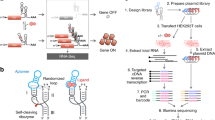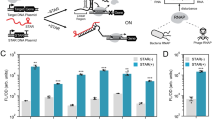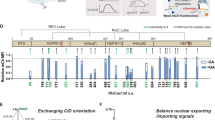Abstract
Natural and engineered RNA 'parts' can perform a variety of functions, including hybridizing to targets, binding ligands and undergoing programmed conformational changes, and catalyzing reactions. These RNA parts can in turn be assembled into synthetic genetic circuits that regulate gene expression by acting either in cis or in trans on mRNAs. As more parts are discovered and engineered, it should be increasingly possible to create synthetic RNA circuits that are able to carry out complex logical operations in cells, either superimposed on or autonomous to extant gene regulation.
This is a preview of subscription content, access via your institution
Access options
Subscribe to this journal
Receive 12 print issues and online access
$259.00 per year
only $21.58 per issue
Buy this article
- Purchase on Springer Link
- Instant access to full article PDF
Prices may be subject to local taxes which are calculated during checkout




Similar content being viewed by others
References
Blencowe, B.J. Alternative splicing: new insights from global analyses. Cell 126, 37–47 (2006).
Henkin, T.M. & Yanofsky, C. Regulation by transcription attenuation in bacteria: how RNA provides instructions for transcription termination/antitermination decisions. Bioessays 24, 700–707 (2002).
Keene, J.D. Ribonucleoprotein infrastructure regulating the flow of genetic information between the genome and the proteome. Proc. Natl. Acad. Sci. USA 98, 7018–7024 (2001).
Lewis, B.P., Burge, C.B. & Bartel, D.P. Conserved seed pairing, often flanked by adenosines, indicates that thousands of human genes are microRNA targets. Cell 120, 15–20 (2005).
Gilbert, W. Origin of life: the RNA world. Nature 319, 618 (1986).
Clop, A. et al. A mutation creating a potential illegitimate microRNA target site in the myostatin gene affects muscularity in sheep. Nat. Genet. 38, 813–818 (2006).
Bartel, D.P. & Chen, C.Z. Micromanagers of gene expression: the potentially widespread influence of metazoan microRNAs. Nat. Rev. Genet. 5, 396–400 (2004).
Hornstein, E. & Shomron, N. Canalization of development by microRNAs. Nat. Genet. 38 (suppl.), 20–24 (2006).
Inouye, M. Antisense RNA: its functions and applications in gene regulation–a review. Gene 72, 25–34 (1988).
Fichou, Y. & Ferec, C. The potential of oligonucleotides for therapeutic applications. Trends Biotechnol. 24, 563–570 (2006).
Dykxhoorn, D.M., Palliser, D. & Lieberman, J. The silent treatment: siRNAs as small molecule drugs. Gene Ther. 13, 541–552 (2006).
Cullen, B.R. Transcription and processing of human microRNA precursors. Mol. Cell 16, 861–865 (2004).
Wassarman, K.M. & Storz, G. 6S RNA regulates E. coli RNA polymerase activity. Cell 101, 613–623 (2000).
Allen, T.A., Von Kaenel, S., Goodrich, J.A. & Kugel, J.F. The SINE-encoded mouse B2 RNA represses mRNA transcription in response to heat shock. Nat. Struct. Mol. Biol. 11, 816–821 (2004).
Espinoza, C.A., Allen, T.A., Hieb, A.R., Kugel, J.F. & Goodrich, J.A. B2 RNA binds directly to RNA polymerase II to repress transcript synthesis. Nat. Struct. Mol. Biol. 11, 822–829 (2004).
Thomas, M. et al. Selective targeting and inhibition of yeast RNA polymerase II by RNA aptamers. J. Biol. Chem. 272, 27980–27986 (1997).
Kettenberger, H. et al. Structure of an RNA polymerase II-RNA inhibitor complex elucidates transcription regulation by noncoding RNAs. Nat. Struct. Mol. Biol. 13, 44–48 (2006).
Held, D.M., Kissel, J.D., Patterson, J.T., Nickens, D.G. & Burke, D.H. HIV-1 inactivation by nucleic acid aptamers. Front. Biosci. 11, 89–112 (2006).
Yan, A.C., Bell, K.M., Breeden, M.M. & Ellington, A.D. Aptamers: prospects in therapeutics and biomedicine. Front. Biosci. 10, 1802–1827 (2005).
Joshi, P.J., Fisher, T.S. & Prasad, V.R. Anti-HIV inhibitors based on nucleic acids: emergence of aptamers as potent antivirals. Curr. Drug Targets Infect. Disord. 3, 383–400 (2003).
Cho, E.J., Rajendran, M. & Ellington, A.D. in Advanced Concepts in Fluorescence Spectroscopy; Macromolecular Sensing (eds. Geddes, C.D. & Lakowicz, J.R.) 127–155 (Springer, Baltimore, 2005).
Knudsen, S.M. & Ellington, A.D. Ribozyme deja vu. Nat. Struct. Mol. Biol. 11, 301–303 (2004).
Winkler, W., Nahvi, A. & Breaker, R.R. Thiamine derivatives bind messenger RNAs directly to regulate bacterial gene expression. Nature 419, 952–956 (2002).
Mironov, A.S. et al. Sensing small molecules by nascent RNA: a mechanism to control transcription in bacteria. Cell 111, 747–756 (2002).
Thore, S., Leibundgut, M. & Ban, N. Structure of the eukaryotic thiamine pyrophosphate riboswitch with its regulatory ligand. Science 312, 1208–1211 (2006).
Serganov, A., Polonskaia, A., Phan, A.T., Breaker, R.R. & Patel, D.J. Structural basis for gene regulation by a thiamine pyrophosphate-sensing riboswitch. Nature 441, 1167–1171 (2006).
Sudarsan, N. et al. Tandem riboswitch architectures exhibit complex gene control functions. Science 314, 300–304 (2006).
Mandal, M. et al. A glycine-dependent riboswitch that uses cooperative binding to control gene expression. Science 306, 275–279 (2004).
Winkler, W.C. & Breaker, R.R. Regulation of bacterial gene expression by riboswitches. Annu. Rev. Microbiol. 59, 487–517 (2005).
Sudarsan, N., Barrick, J.E. & Breaker, R.R. Metabolite-binding RNA domains are present in the genes of eukaryotes. RNA 9, 644–647 (2003).
Kubodera, T. et al. Thiamine-regulated gene expression of Aspergillus oryzae thiA requires splicing of the intron containing a riboswitch-like domain in the 5′-UTR. FEBS Lett. 555, 516–520 (2003).
Doudna, J.A. & Lorsch, J.R. Ribozyme catalysis: not different, just worse. Nat. Struct. Mol. Biol. 12, 395–402 (2005).
Winkler, W.C., Nahvi, A., Roth, A., Collins, J.A. & Breaker, R.R. Control of gene expression by a natural metabolite-responsive ribozyme. Nature 428, 281–286 (2004).
Teixeira, A. et al. Autocatalytic RNA cleavage in the human beta-globin pre-mRNA promotes transcription termination. Nature 432, 526–530 (2004).
Salehi-Ashtiani, K., Luptak, A., Litovchick, A. & Szostak, J.W. A genomewide search for ribozymes reveals an HDV-like sequence in the human CPEB3 gene. Science 313, 1788–1792 (2006).
Przybilski, R. et al. Functional hammerhead ribozymes naturally encoded in the genome of Arabidopsis thaliana. Plant Cell 17, 1877–1885 (2005).
Fiammengo, R. & Jaschke, A. Nucleic acid enzymes. Curr. Opin. Biotechnol. 16, 614–621 (2005).
Soukup, G.A. & Breaker, R.R. Engineering precision RNA molecular switches. Proc. Natl. Acad. Sci. USA 96, 3584–3589 (1999).
Robertson, M.P. & Ellington, A.D. In vitro selection of an allosteric ribozyme that transduces analytes to amplicons. Nat. Biotechnol. 17, 62–66 (1999).
Robertson, M.P. & Ellington, A.D. In vitro selection of nucleoprotein enzymes. Nat. Biotechnol. 19, 650–655 (2001).
Vaish, N.K. et al. Monitoring post-translational modification of proteins with allosteric ribozymes. Nat. Biotechnol. 20, 810–815 (2002).
Atsumi, S., Ikawa, Y., Shiraishi, H. & Inoue, T. Design and development of a catalytic ribonucleoprotein. EMBO J. 20, 5453–5460 (2001).
Hartig, J.S. et al. Protein-dependent ribozymes report molecular interactions in real time. Nat. Biotechnol. 20, 717–722 (2002).
Robertson, M.P., Knudsen, S.M. & Ellington, A.D. In vitro selection of ribozymes dependent on peptides for activity. RNA 10, 114–127 (2004).
Najafi-Shoushtari, S.H., Mayer, G. & Famulok, M. Sensing complex regulatory networks by conformationally controlled hairpin ribozymes. Nucleic Acids Res. 32, 3212–3219 (2004).
Breaker, R.R. Engineered allosteric ribozymes as biosensor components. Curr. Opin. Biotechnol. 13, 31–39 (2002).
Wu, A.M. & Senter, P.D. Arming antibodies: prospects and challenges for immunoconjugates. Nat. Biotechnol. 23, 1137–1146 (2005).
Homann, M. & Goringer, H.U. Combinatorial selection of high affinity RNA ligands to live African trypanosomes. Nucleic Acids Res. 27, 2006–2014 (1999).
Shangguan, D. et al. Aptamers evolved from live cells as effective molecular probes for cancer study. Proc. Natl. Acad. Sci. USA 103, 11838–11843 (2006).
Lupold, S.E., Hicke, B.J., Lin, Y. & Coffey, D.S. Identification and characterization of nuclease-stabilized RNA molecules that bind human prostate cancer cells via the prostate-specific membrane antigen. Cancer Res. 62, 4029–4033 (2002).
Chu, T.C. et al. Aptamer:toxin conjugates that specifically target prostate tumor cells. Cancer Res. 66, 5989–5992 (2006).
Farokhzad, O.C. et al. Nanoparticle-aptamer bioconjugates: a new approach for targeting prostate cancer cells. Cancer Res. 64, 7668–7672 (2004).
Farokhzad, O.C. et al. Targeted nanoparticle-aptamer bioconjugates for cancer chemotherapy in vivo. Proc. Natl. Acad. Sci. USA 103, 6315–6320 (2006).
Chu, T.C., Twu, K.Y., Ellington, A.D. & Levy, M. Aptamer mediated siRNA delivery. Nucleic Acids Res. 34, e73 (2006).
McNamara, J.O. II, et al. Cell type-specific delivery of siRNAs with aptamer-siRNA chimeras. Nat. Biotechnol. 24, 1005–1015 (2006).
Werstuck, G. & Green, M.R. Controlling gene expression in living cells through small molecule-RNA interactions. Science 282, 296–298 (1998).
Grate, D. & Wilson, C. Inducible regulation of the S. cerevisiae cell cycle mediated by an RNA aptamer-ligand complex. Bioorg. Med. Chem. 9, 2565–2570 (2001).
Harvey, I., Garneau, P. & Pelletier, J. Inhibition of translation by RNA-small molecule interactions. RNA 8, 452–463 (2002).
Hanson, S., Bauer, G., Fink, B. & Suess, B. Molecular analysis of a synthetic tetracycline-binding riboswitch. RNA 11, 503–511 (2005).
Suess, B. et al. Conditional gene expression by controlling translation with tetracycline-binding aptamers. Nucleic Acids Res. 31, 1853–1858 (2003).
Hanson, S., Berthelot, K., Fink, B., McCarthy, J.E. & Suess, B. Tetracycline-aptamer-mediated translational regulation in yeast. Mol. Microbiol. 49, 1627–1637 (2003).
Kim, D.S., Gusti, V., Pillai, S.G. & Gaur, R.K. An artificial riboswitch for controlling pre-mRNA splicing. RNA 11, 1667–1677 (2005).
Suess, B., Fink, B., Berens, C., Stentz, R. & Hillen, W. A theophylline responsive riboswitch based on helix slipping controls gene expression in vivo. Nucleic Acids Res. 32, 1610–1614 (2004).
Desai, S.K. & Gallivan, J.P. Genetic screens and selections for small molecules based on a synthetic riboswitch that activates protein translation. J. Am. Chem. Soc. 126, 13247–13254 (2004).
Kertsburg, A. & Soukup, G.A. A versatile communication module for controlling RNA folding and catalysis. Nucleic Acids Res. 30, 4599–4606 (2002).
Thompson, K.M., Syrett, H.A., Knudsen, S.M. & Ellington, A.D. Group I aptazymes as genetic regulatory switches. BMC Biotechnol. [online] 2, 21 (2002).
Yen, L. et al. Exogenous control of mammalian gene expression through modulation of RNA self-cleavage. Nature 431, 471–476 (2004).
Yen, L., Magnier, M., Weissleder, R., Stockwell, B.R. & Mulligan, R.C. Identification of inhibitors of ribozyme self-cleavage in mammalian cells via high-throughput screening of chemical libraries. RNA 12, 797–806 (2006).
Isaacs, F.J. et al. Engineered riboregulators enable post-transcriptional control of gene expression. Nat. Biotechnol. 22, 841–847 (2004).
Lease, R.A., Cusick, M.E. & Belfort, M. Riboregulation in Escherichia coli: DsrA RNA acts by RNA:RNA interactions at multiple loci. Proc. Natl. Acad. Sci. USA 95, 12456–12461 (1998).
Bayer, T.S. & Smolke, C.D. Programmable ligand-controlled riboregulators of eukaryotic gene expression. Nat. Biotechnol. 23, 337–343 (2005).
An, C.I., Trinh, V.B. & Yokobayashi, Y. Artificial control of gene expression in mammalian cells by modulating RNA interference through aptamer-small molecule interaction. RNA 12, 710–716 (2006).
SenGupta, D.J. et al. A three-hybrid system to detect RNA-protein interactions in vivo. Proc. Natl. Acad. Sci. USA 93, 8496–8501 (1996).
Sengupta, D.J., Wickens, M. & Fields, S. Identification of RNAs that bind to a specific protein using the yeast three-hybrid system. RNA 5, 596–601 (1999).
Saha, S., Ansari, A.Z., Jarrell, K.A. & Ptashne, M. RNA sequences that work as transcriptional activating regions. Nucleic Acids Res. 31, 1565–1570 (2003).
Buskirk, A.R., Kehayova, P.D., Landrigan, A. & Liu, D.R. In vivo evolution of an RNA-based transcriptional activator. Chem. Biol. 10, 533–540 (2003).
Buskirk, A.R., Landrigan, A. & Liu, D.R. Engineering a ligand-dependent RNA transcriptional activator. Chem. Biol. 11, 1157–1163 (2004).
Elowitz, M.B. & Leibler, S. A synthetic oscillatory network of transcriptional regulators. Nature 403, 335–338 (2000).
Gardner, T.S., Cantor, C.R. & Collins, J.J. Construction of a genetic toggle switch in Escherichia coli. Nature 403, 339–342 (2000).
Levskaya, A. et al. Synthetic biology: engineering Escherichia coli to see light. Nature 438, 441–442 (2005).
Benenson, Y., Gil, B., Ben-Dor, U., Adar, R. & Shapiro, E. An autonomous molecular computer for logical control of gene expression. Nature 429, 423–429 (2004).
Stojanovic, M.N. & Stefanovic, D. A deoxyribozyme-based molecular automaton. Nat. Biotechnol. 21, 1069–1074 (2003).
Acknowledgements
We would like to thank M. Levy for help with figure preparation.
Author information
Authors and Affiliations
Corresponding author
Ethics declarations
Competing interests
A.E. is a founder of Archemix, which works on therapeutic applications of aptamers.
Rights and permissions
About this article
Cite this article
Davidson, E., Ellington, A. Synthetic RNA circuits. Nat Chem Biol 3, 23–28 (2007). https://doi.org/10.1038/nchembio846
Published:
Issue Date:
DOI: https://doi.org/10.1038/nchembio846



